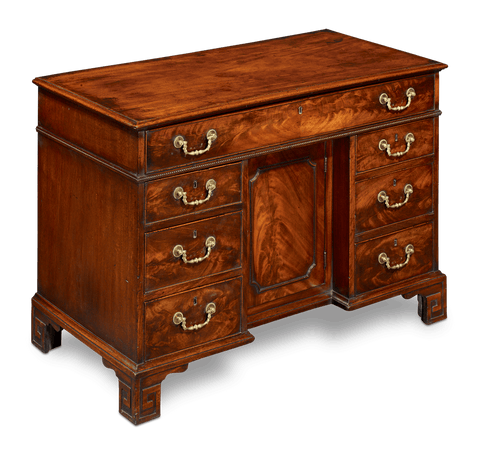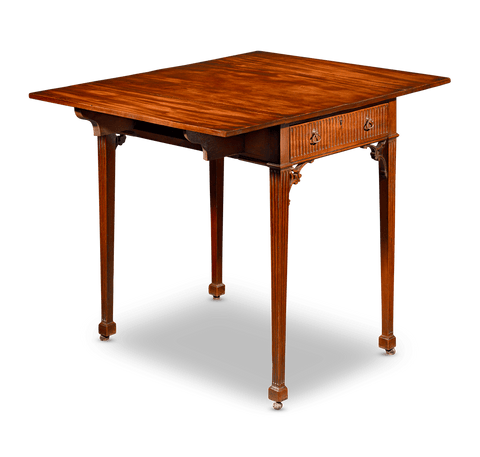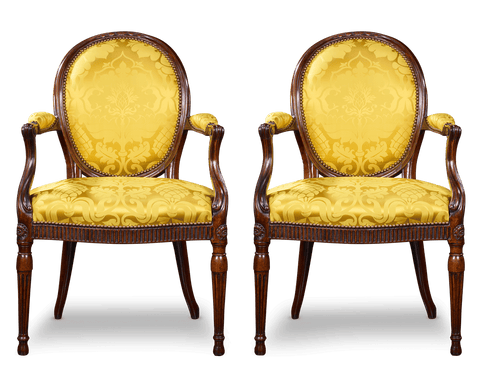Artists & Artisans
Chippendale, Thomas
(1718-1779) I British
Thomas Chippendale, the renowned cabinetmaker, and furniture designer of the mid-Georgian era is considered one of the most important furniture designers in history. Chippendale's mastery of furniture design and construction extended not only to the external aesthetics but also to the interior aspects of his exquisite pieces.
In fact, Chippendale's influence was so profound that an entire furniture style bears his name, a testament to his exceptional following independent of royal patronage. His dedication to craftsmanship was evident in his choice of materials, as he consistently utilized the highest quality timbers and sought the finest mounts to adorn his creations. Every piece of furniture that emerged from Chippendale's workshop was imbued with his relentless pursuit of excellence.
Early Life
Born in the quaint town of Otley, England in 1718, Chippendale was introduced to the woodworking trade, a craft deeply ingrained in his family heritage, after completing his elementary education. Little is known about his early years until his marriage to Catherine Redshaw in 1748. The couple settled in St. Martin's Lane, a burgeoning epicenter for the furniture market, where Chippendale's residence transformed into a workshop and showroom.Rise to Fame
From his location on St. Martin's Lane, Chippendale ambitiously pioneered revolutionary furniture projects, delivering exquisite craftsmanship to affluent households across Britain. In 1754, he achieved wider acclaim with the publication of the illustrious Gentlemen and Cabinet-Maker's Director. This remarkable collection of furniture designs proved to be a groundbreaking publication, garnering widespread reverence and establishing Chippendale as a preeminent tastemaker in England.A skilled businessman and adept publicist, Chippendale cultivated an extensive network of wealthy clients across Europe and the Americas, securing lucrative contracts that propelled his business to new heights. By 1755, he commanded a workforce of 40 to 50 artisans, leading the charge in executing his designs. In 1759, his accomplishments earned him a prestigious election to the Society of Arts.
Prestigious Partnerships
Throughout his career, Chippendale forged various partnerships that contributed to the growth and evolution of his enterprise. He joined forces with James Rannie, a wealthy Scottish merchant, and later with Thomas Haig in 1771. In 1776, Chippendale's son, also named Thomas, assumed control of the company. Unfortunately, financial challenges plagued the firm, with delayed client payments and cash flow as constant hurdles. Haig's passing in 1804 eventually led to the closure of the business.Death and Legacy
In 1772, Chippendale suffered the loss of his first wife, Catherine and in 1777, he entered a second marriage with Elizabeth Davis. Only two brief years later, Thomas Chippendale himself passed away, leaving behind a profound legacy. Chippendale was the first civilian to boast such a strong following that an entire style bears his name, an honor typically reserved for monarchs and royalty. For generations to follow, the Chippendale name remained an enduring standard bearer in the world of furniture. Many later esteemed craftsmen sought to carry on in Chippendale’s tradition of excellence.Among his distinguished clientele were notable figures such as Catherine II of Russia, celebrated actor David Garrick and the illustrious noble houses of Nostell Priory, Harewood House, Burton Constable, Ayrshire, Kent, and many more. Today, numerous commissioned works for these esteemed patrons still grace the most prestigious private royal collections, a testament to the enduring legacy of Chippendale's craftsmanship.
Quick Facts:
-
He was born in Otley, Yorkshire, England in 1718.
-
He was a cabinetmaker and furniture designer in the mid-Georgian, English Rococo and Neoclassical styles.
-
In 1754 he published The Gentleman and Cabinet-Maker's Director, a pattern book that helped secure his position as one of the most eminent cabinetmakers of the 18th century.
-
He was elected to the Society of Arts in 1759.
-
He was appointed cabinetmaker to the Prince of Wales in 1762.
-
Spouses:
-
Catherine Redshaw
-
Elizabeth Davis
-
He died in London in 1779
Artists & Artisans
Chippendale, Thomas
(1718-1779) I British
Thomas Chippendale, the renowned cabinetmaker, and furniture designer of the mid-Georgian era is considered one of the most important furniture designers in history. Chippendale's mastery of furniture design and construction extended not only to the external aesthetics but also to the interior aspects of his exquisite pieces.
In fact, Chippendale's influence was so profound that an entire furniture style bears his name, a testament to his exceptional following independent of royal patronage. His dedication to craftsmanship was evident in his choice of materials, as he consistently utilized the highest quality timbers and sought the finest mounts to adorn his creations. Every piece of furniture that emerged from Chippendale's workshop was imbued with his relentless pursuit of excellence.
Early Life
Born in the quaint town of Otley, England in 1718, Chippendale was introduced to the woodworking trade, a craft deeply ingrained in his family heritage, after completing his elementary education. Little is known about his early years until his marriage to Catherine Redshaw in 1748. The couple settled in St. Martin's Lane, a burgeoning epicenter for the furniture market, where Chippendale's residence transformed into a workshop and showroom.Rise to Fame
From his location on St. Martin's Lane, Chippendale ambitiously pioneered revolutionary furniture projects, delivering exquisite craftsmanship to affluent households across Britain. In 1754, he achieved wider acclaim with the publication of the illustrious Gentlemen and Cabinet-Maker's Director. This remarkable collection of furniture designs proved to be a groundbreaking publication, garnering widespread reverence and establishing Chippendale as a preeminent tastemaker in England.A skilled businessman and adept publicist, Chippendale cultivated an extensive network of wealthy clients across Europe and the Americas, securing lucrative contracts that propelled his business to new heights. By 1755, he commanded a workforce of 40 to 50 artisans, leading the charge in executing his designs. In 1759, his accomplishments earned him a prestigious election to the Society of Arts.
Prestigious Partnerships
Throughout his career, Chippendale forged various partnerships that contributed to the growth and evolution of his enterprise. He joined forces with James Rannie, a wealthy Scottish merchant, and later with Thomas Haig in 1771. In 1776, Chippendale's son, also named Thomas, assumed control of the company. Unfortunately, financial challenges plagued the firm, with delayed client payments and cash flow as constant hurdles. Haig's passing in 1804 eventually led to the closure of the business.Death and Legacy
In 1772, Chippendale suffered the loss of his first wife, Catherine and in 1777, he entered a second marriage with Elizabeth Davis. Only two brief years later, Thomas Chippendale himself passed away, leaving behind a profound legacy. Chippendale was the first civilian to boast such a strong following that an entire style bears his name, an honor typically reserved for monarchs and royalty. For generations to follow, the Chippendale name remained an enduring standard bearer in the world of furniture. Many later esteemed craftsmen sought to carry on in Chippendale’s tradition of excellence.Among his distinguished clientele were notable figures such as Catherine II of Russia, celebrated actor David Garrick and the illustrious noble houses of Nostell Priory, Harewood House, Burton Constable, Ayrshire, Kent, and many more. Today, numerous commissioned works for these esteemed patrons still grace the most prestigious private royal collections, a testament to the enduring legacy of Chippendale's craftsmanship.
Quick Facts:
-
He was born in Otley, Yorkshire, England in 1718.
-
He was a cabinetmaker and furniture designer in the mid-Georgian, English Rococo and Neoclassical styles.
-
In 1754 he published The Gentleman and Cabinet-Maker's Director, a pattern book that helped secure his position as one of the most eminent cabinetmakers of the 18th century.
-
He was elected to the Society of Arts in 1759.
-
He was appointed cabinetmaker to the Prince of Wales in 1762.
-
Spouses:
-
Catherine Redshaw
-
Elizabeth Davis
-
He died in London in 1779






